




Be that as it may, this catalog or any portion there of may not be reproduced or used in any manner whatsoever without express written permission from Peripheral ARTeries and featured artists.

Lives and works in Norwich, United Kingdom
Lives and works in the Greater New York City Area
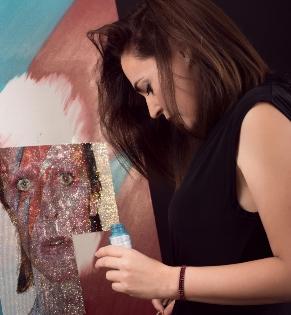
Lives and works in Seattle, WA, United States
Lives and works in Brussels, Belgium
Lives and works in Bristol, United Kingdom
Lives and works in Chicago, Illinois, USA
Lives and works in Eindhoven, The Netherlands

Lives and works in Jerusalem, Israel
Lives and works in Tel Aviv, Israel

Special thanks to: Isabel Becker, Julia Überreiter, Deborah Esses, Xavier Blondeau, Margaret Noble, Nathalie Borowski, Marco Visch, Xavier Blondeau, J.D. Doria, Matthias Callay, Luiza Zimerman, Kristina Sereikaite, Scott D'Arcy, Kalli Kalde, Carla Forte, Mathieu Goussin, Dorothee Zombronner, Olga Karyakina, Robert Hamilton, Carrie Alter, Jessica Bingham, Fabian Freese, Elodie Abergel, Ellen van der Schaaf, Courtney Henderson, Ben Hollis, Riley Arthur, Ido Friedman, Nicole Ennemoser, Scott Vogel, Tal Regev, Sarah Hill, Olivia Punnet and Simon Raab

Kieta Jackson’s textile sculptures demonstrate two things, wonderful elegant containing forms and a sense of antiquity in another world and time. She works primarily with wires and sheet metal and builds vessels and forms of crocheted and woven fabric.
‘The process starts with a fine gauge wire which is then woven on a loom by hand, creating a malleable fabric which is manipulated into the sculptural identity.’ ‘I am always thriving to create a harmonious relationship with material and forms so the sculptures resonate found artefacts, archaeological remains and elements from the sea’
Whist her pieces adopt shapes borrowed from unearthed objects she also distresses and applies patina’s to the surfaces of the metal, often leaving warped threads left hanging loosely, conveying deterioration and corrosion. We are left believing that her sensitive forms are ancient artefacts one would view in a museum, or have been long forgotten.
After graduating with a BA (Hons) degree from Norwich School of Art and design in 1999, Kieta has had a constant flow of Exhibitions Nationally and internationally. Gained an Award of Distinction from the 5th Baltic Biennial of Miniature Weavers, Poland, 2001 and had her work published in Jac Scott’s ‘Textile perspective in Mixed Media Sculptures’ 2003 and Fibre Arts Magazine, spring 2015.
Kieta has established a unique area of practice by her use of textiles in metal.

Vessel, 2016. 9 x 4.5 x 6.5cm. (woven copper and brass)
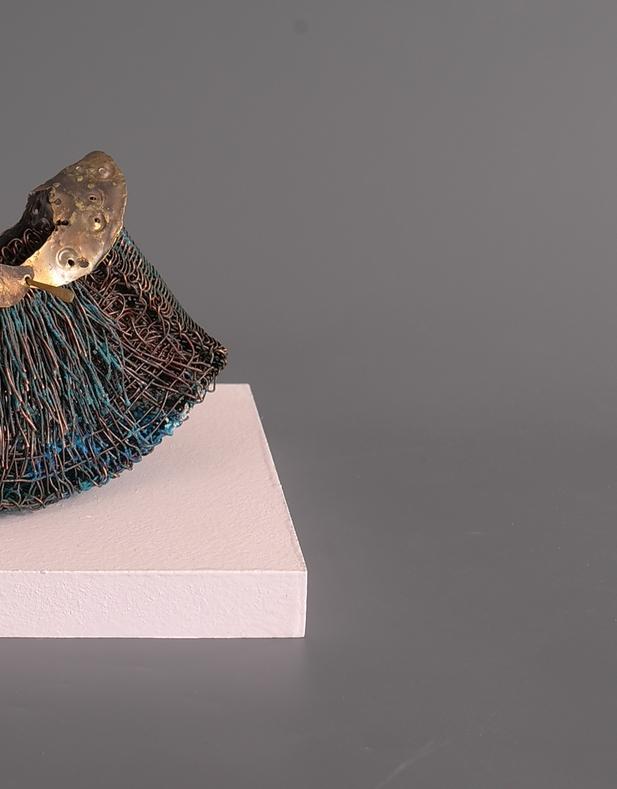
Experimenting with a wide variety of materials to express the ideas she explores, artist Kieta Jackson's work rejects any conventional classification regarding its style. In her captivating body of works that we'll be discussing in the following pages, she successfully attempts to trigger the spectatorship's perceptual parameters, with a deeper focus on a complementary dialogue between antiquity and contemporary sensitiveness. One of the most impressive aspects of Jackson's work is the way it accomplishes the difficult task of inquiring into the liminal area where the abstract and the figurative find an unexpected still consistent point of convergence: we are very pleased to introduce our readers to her stimulating and multifaceted artistic production.
An interview by Josh Ryders, curator and Melissa C. Hilborn, curator peripheral.arteries@europe.comHello Kieta and welcome to Peripheral ARTeries: we would start this interview with a couple of questions about your background. Are there any experience that did particularly influence the way you currently relate yourself to art making and to the notion of beauty?
Both my parents collected artifacts and curiosities from around the world. My father was in the Merchant Navy and picked up objects of art and craft from the many countries he visited. When not working and at home he would teach me knot and canvas work.
My Mother worked in antique shops and
taught me how to knit and crochet, so learning and honing skills at an early age. I grew up in a house full of unusual objects, antiques and tribal artifacts, which on a subconscious level inspired me in later life, drawing my attention to fish traps and oceanic art, especially from areas around Papua New Guinea.
Your works convey a coherent sense of unity, that rejects any conventional classification. Before starting to elaborate about your production, we would suggest to our readers to visit https://www.kietajackson.com in order to get a synoptic view of your work: in the meanwhile, would you like to tell to our readers something about your process and set up? How much importance does play spontaneity in your work? In

 Curator, 2016. 33 x 22 x 10 cm. ( woven and crochet copper)
Curator, 2016. 33 x 22 x 10 cm. ( woven and crochet copper)
Origin unknown, 2014. 27x24x24cm. woven copper.
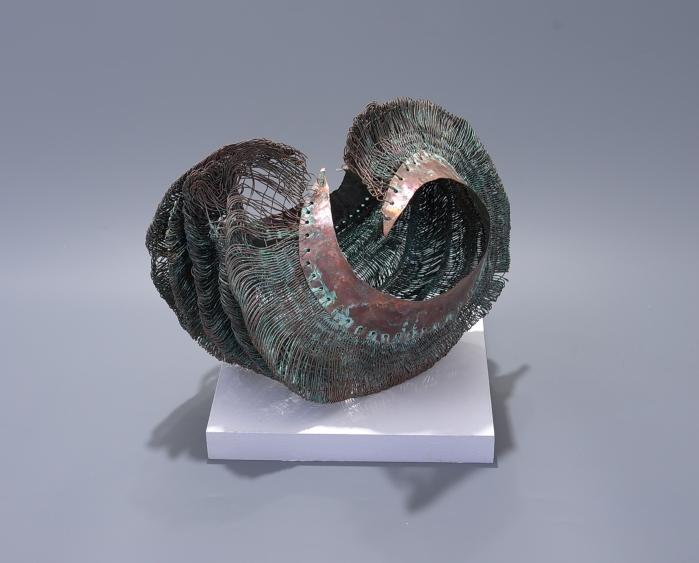
particular, do you conceive you works instinctively or do you methodically elaborate your pieces?
There are various stages of making, first there is the warping up of the loom followed by the weaving. Once woven the assemblage begins, this is the most
creative and exciting part. In the begining I often have a fixed concept but the medative motion of the weaving process allows my thoughts to grow and wonder.
Although aware that I am effected by my surroundings, I cannot immediately
identify where the ideas for the sculpted forms have materialised from. Some of my works have an apparent similarity to my collection of ceramics. It is a rather intuitive process of working, influenced partly by, the tribal jewellery works of Alexander Calder, Lynn Chadwick’s iron and steel sculptures and the iconic carvings of Barbara Hepworth
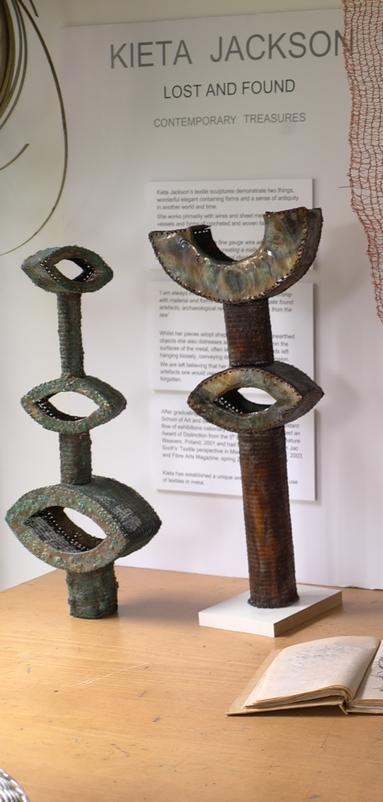
Do you think that there are any central ideas that connect all of your work as an artist?
My most natural and instinctive ideas have always had a sense of bringing the past into the present. Very much inspired by Modern and Tribal Art with the lines, textures, patterns and forms. I have recently been making paper and card maquettes and although no constructed textile techniques are involved, I cannot stop myself applying decorative designs to the surfaces incorperating wire, adding colour, rusts and texture or simply drawing on designs with a felt tip pen. These maquettes have become art works in themselves.
For this special edition of Peripheral ARTeries we have selected Origin unknown and Curator, a couple of interesting works that our readers have already started to got to know in the introductory pages of this article. What has at once captured our attention of your artistic inquiry into the relationship between form and material is the way you provided the visual results of your analysis with autonomous aesthetics:
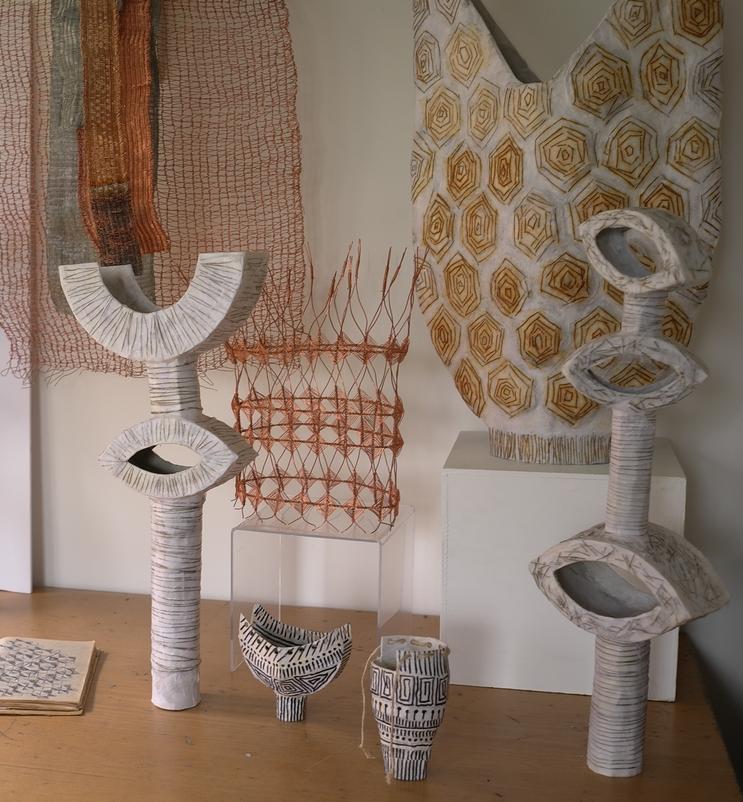
Navigo, 2016. 27x29x10cm. Woven copper

when walking our readers through the genesis of Origin unknown and Curator would you tell us your sources of inspiration?
The texture and colours under the sea, stitched together with archaeological finds and memories of old Jacques Cousteau films, with the faded patina’s of ship wrecks and wonderful forms of sealife, was the inspiration for ‘Origin Unknown’.
‘Curator’ came about from oceanic tribes and their cermonial costumes and headdresses, the layering of found objects, shells, feathers and grasses to create wonderful traditional displays.
Primarily with sheet metal , the unique way you combine your materials shows that you are a versatile artist capable of capturing the unsuspected expressive potential of your media: what are the properties you are searching for in the materials that you include in your materials? And in particular, what did initially draw you to focus on wires and sheet metal?
In my student days one had to be thrifty with money so I used recycled copper wire.
In the early 90’s British Telecom replaced all of their wiring system and I managed to source a large amount of the old plastic coated fine gauge copper wire. After stripping the plastic coating off I instictively began to crochet with it. I


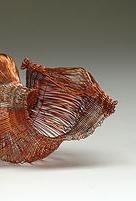
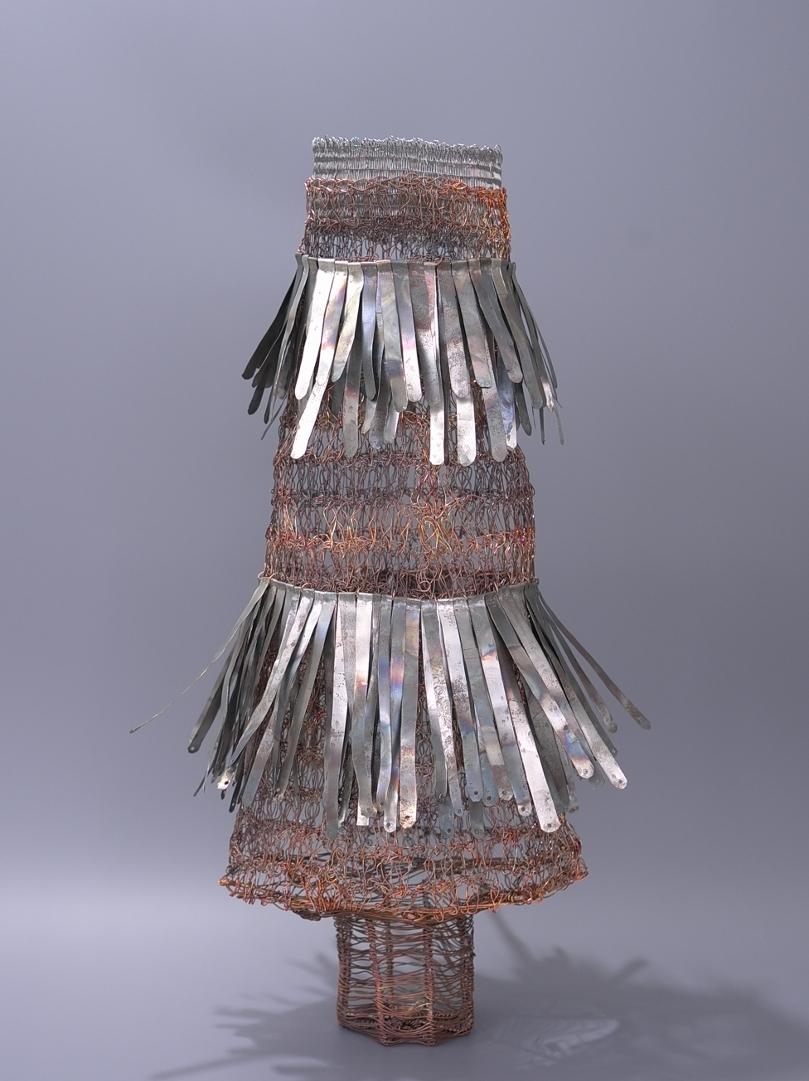
loved this new way of using wire in a textile way. Once I started my degree course and got to grips with warping up a weaving loom I soon began weaving in wire.
During this time I enrolled onto an evening class in silversmithing, broadening my understanding of metal which allowed me to start annealing the metal fabrics I had woven and manipulating them into forms and textures, there seems to be no boundaries.
Later works incorporate sheet metal, changing the fragility of my work, giving contrast physically and asthetically. You can see in ‘Arte Factum’ the visibility of stitching through openings and the embossed areas in metal which add a subtle change to the contrasting surfaces.
Where as ‘Bellator’ is a fragile crocheted frame, adorned with layering small steel strips one on top of the other giving it a sense of strength, that provoke thoughts of age old tribal dancers, with their enhanced agility and power, from the costume that embelishes them.
Your works provide the the observer a unique experience and sometimes without the need for explanations and clarifications: what do you think about the role of the viewer? Are you particularly interested if you try to achieve to trigger the viewers' perception as starting point to urge
them to elaborate personal interpretations?
There is a mystery surrounding ancient artifacts for instance ‘Navigo’ is about a journey but where is it going? Where has it come from? History has intrigue and holds secrets; no one knows the real story unless it was there to be experienced in the first place. It is up to the viewers interpretation to create their own story or perception. I would like my audience to see my works as museum pieces and artifacts long been forgotten.
Multidisciplinary artist Angela Bulloch onced remarked "that works of arts often continue to evolve after they have been realised, simply by the fact that they are conceived with an element of change, or an inherent potential for some kind of shift to occur". As an artist working with unconventional materials, do you think that the role of the artist has changed these days with the new global communications and the new sensibility created by new media?
It has definately opened up new pathways for artists to have their work viewed by a larger audience.
As a Contemporary Textile Artist I have not felt a role change as I still use traditional techniques in the process of what I do.
How do you go about naming your sculptures? In particular, is important for
you to tell something that might walk the viewers through their visual experience?
I have a tendency to use Latin when naming my work. This Neo Classical language, has been used in conjunction with collections and the world of science. It is also the backbone of European languages today and has its own journey of history and time that is burried
somewhat in the new languages. This adds another veneer of curiosity and mystery to the sculptures.

Your sculptures are marked with a captivating very ambivalent quality and while resonating archaeological remains belonging to real world also convey a stimulating abstract feature: how do you view the concepts of the real and the imagined playing out within your works?

Arte Factum III, 2015, Crocheted copper

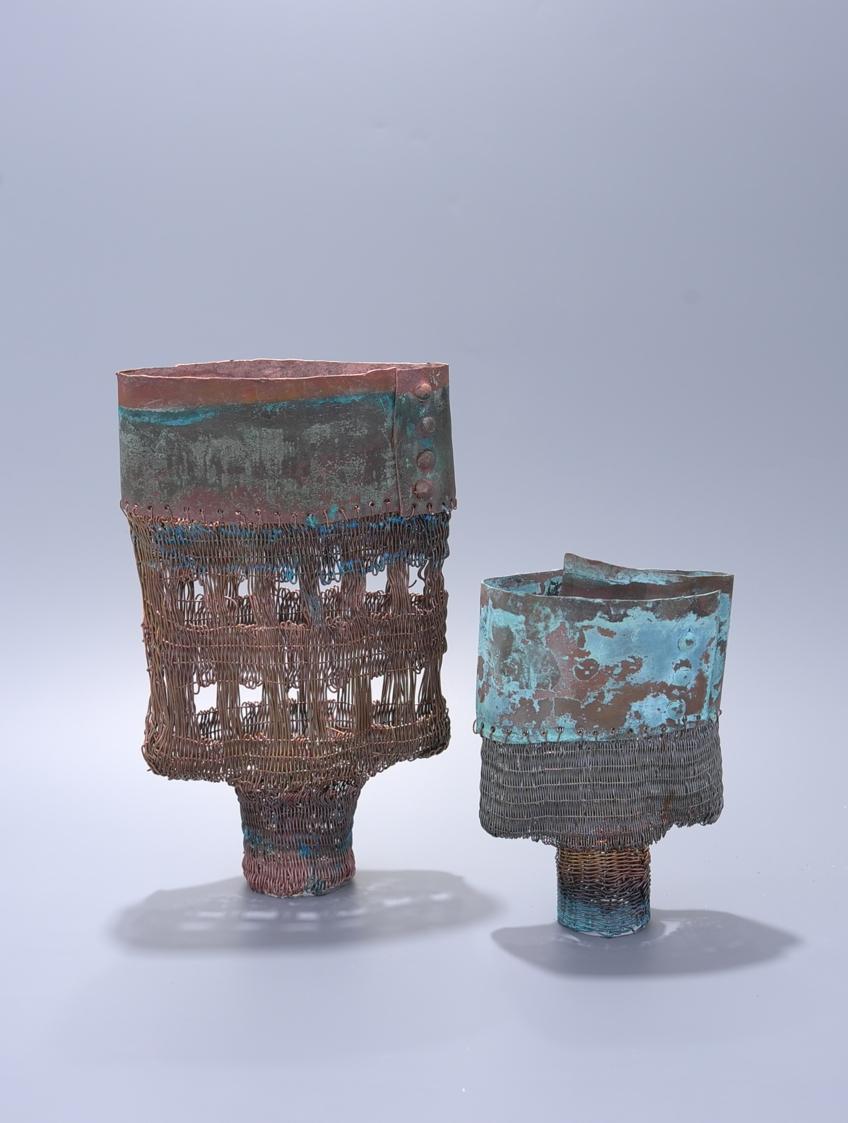
How would you define the relationship between abstraction and representation in your practice?
Line, shape, form, colour and texture are the impressions abstracted from my chosen subject matters. The combining elements of abstract and representation compose a visually stimulating balance evolving into a desired aesthetic.
Over theyears your works have been showcased in several occasions, you had four solos ad you participated in a number of group exhibition, including your recent participation to Farnsworth Mercantile, in San Francisco. One of the hallmarks of your practice is the capability to create direct involvement with the viewers, who are urged to evolve from a condition of mere spectatorship. So before leaving this conversation we would like to
pose a question about the nature of the relationship of your art with your audience. Do you consider the issue of audience reception as being a crucial component of your decision-making process, in terms of what type of language is used in a particular context?
The original making process and idea, is no way informed by the reception of the audience, so no it is not a crucial component.
The creation of the work is my creative journey and it is not until the work is exhibited, that the language of the piece
and its context with the audience is confirmed. The viewer or audience can then take away with them a sense of what the piece of work evokes to them. Therefore the works of art are not made to manipulate the audience
Thanks a lot for your time and for sharing your thoughts, Kieta. Finally, would you like to tell us readers something about your future projects? How do you see your work evolving?
There are thoughts of moving the flexibility of line and weave into a more solid medium. Bronze casting may well be a path to investigate and bronze like copper reacts to certain chemicals, creating patinations on the surfaces . Artist Klaus Ihlenfeld captures a beautiful verdigris on the surface of his wonderful abstract bronze sculptures, and it is his works that have helped inform my potential exploration of this wonderful medium.
Casting also opens up the ideas of size and working to a much larger scale. The paper and card maquettes would be interesting to cast, with the subtle textured patterns leading to a new exciting body of work.
An interview by Josh Ryders, curator and Katherine Williams, curator peripheral.arteries@europe.com
Danielle Baudrand is an emerging self-taught artist, working primarily in mixed media. She often uses discarded objects, and explores the feelings associated with discarded objects. Her most recent work The Plastic Bag Project uses the repeated process of braiding and crocheting bags together to make one long chain that reaches over four football fields long. In this process she turns the thoughtlessness of discarded objects into mindfulness.
Rejecting any conventional classification regarding its style, artist Danielle Baudrand explores contemporary phenomena that affect our media driven and unstable societies, to draw the viewers through an unconventional and multilayered experience. In The Plastic Bag Project that we'll be discussing in the following pages, she successfully attempts to trigger the spectatorship's perceptual parameters. One of the most impressive aspects of Baudrand's work is the way it accomplishes the difficult task of educating and inspire people to want to bring about change and protect our planet: we are very pleased to introduce our readers to her stimulating and multifaceted artistic production.
Hello Danielle and welcome to Peripheral ARTeries: we would start this interview with a couple of questions about your background. You are basically a self-taught
artist: are there any particular experiences that influenced the way you currently conceive your works? And in particular, how does your cultural substratum address your artistic inquiry?
Thank you for inviting me! Yes, I am basically a self-taught artist. However, in college, I majored in Political Science and minored in Film Studies and Religion. I also took some photography and drawing classes; however, I felt that studying these art forms in a structured manner was not enjoyable for me at all but rather boring. Nonetheless, looking at art and thinking about it awoke something inside of me, and I began to work on independent projects outside of what was required of me from my classes. My film professor introduced me to a broad range of experimental filmmakers such as Stan Brakhage and Maya Deren who continue to influence and inspire me. Their non-traditional methods aroused my curiosity and encouraged my own desire to play with different layers, sounds, textures and movement in space in my own films.

 Danielle Baudrand
Danielle Baudrand
It wasn’t until years later after I had moved to New York City that I began to fuse my political outlook with my creative sensibilities. Specifically, living in a crowded city that generates massive amounts of garbage made me want to focus on the problem of our disposable culture.
My husband and daughter and I were renting a tiny, overpriced 1-bedroom apartment when I began working on the Plastic Bag Project. There was no shortage of single-use plastic bags, so I began collecting them and braiding them and crocheting them together. I enjoyed the repetitive, meditative nature of the work, but as the project went on for days and then weeks and then months and then years, I began to realize that there was no end, that this stream of non-biodegradable garbage was endless.
It was the combination of that tactile experience and a great interest in reviving my interest in spiritual readings such as Kabbalism and Buddhism that lead to a stream of consciousness that initiated this response of mindfulness.
Your works convey a coherent sense of unity that rejects any conventional classification: would you like to tell to our readers something about your process and set up? How much importance does play spontaneity in your work? In particular, do you conceive you work instinctively or do you methodically elaborate your pieces?
I’m a very instinctive artist. I rarely plan my projects. I might have a broad idea about a topic that I want to address, but I never know how a work is going to turn out before I begin.I approach it like a giant puzzle looking for pieces to put together. Often, I sit and clear my
mind, and just hold the materials until I have a sense of their essence and malleability. In this way it’s very meditative. I quite enjoy this process and find it to be very therapeutic. What seems logical does not always fit into the art piece. Sometimes I will let it sit and ferment for a period of time until I feel the need to approach it again. That is what I enjoy about art that is not conventional – the lack of rules and the freedom to create movement within the art piece. It takes patience but I am never in a hurry to finish a piece. Rather, I am interested in what kind of life and form takes shape.
This is really evident in The Plastic Bag Project, which was done over a four-year period in many places. I never have a studio and work out of spaces that are available to me. The project was created out of instinct and later took on a method. The repeated process of cleaning, cutting, braiding and crocheting the bags together into one single strand became very ritualistic and meditative.
There is a great deal of play in my work. I like art that has movement and can change in different spaces, constantly evolving and revealing new characteristics. During installations and exhibits, often I rely on others to determine how to interpret the project in a given space. The art piece then becomes interactive and takes on many new forms because of this open approach. It is meant to be participatory so that everyone can interact and develop interpretations that strengthen the power of the piece itself.
Lastly, my family has had an influence on my art for the simple reason that my studio is always within our living space -- a kitchen, a living room, a bedroom.
For this special edition of Peripheral ARTeries we have selected The Plastic Bag Project, an interesting work that our readers have already started to got to know in the introductory pages of this article and that can be viewed at https://www.facebook.com/theplasticbagproj ect. What has at once captured our attention of your inquiry into the issue of plastic bag pollution is the way you provided its visual results of it with autonomous aesthetics: when walking our readers through the genesis of The Plastic Bag Project would you tell us your sources of inspiration?
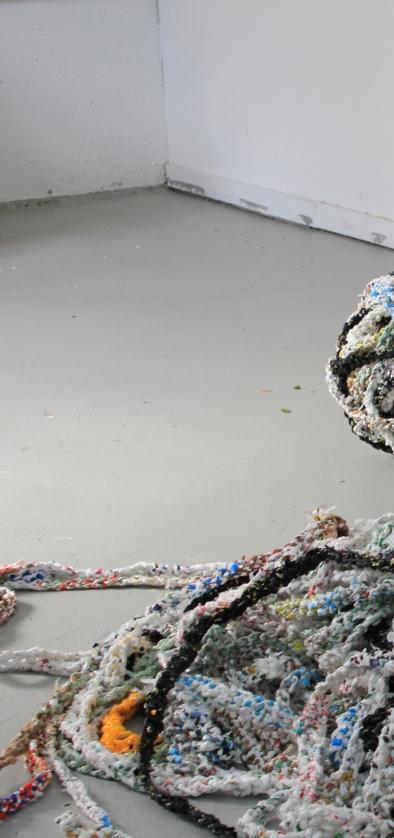
My inspiration for this project really came from the streets of NYC. Every block was unique and displayed a different visual array of gray concrete in a world that operated 24/7. As an artist, I always found myself outside exploring the curbsides of NYC and bringing home a variety of discarded objects. I started repurposing canvases, tables, chairs or whatever else was left behind. Because I lived in a small space and had no studio, I had to find materials I could work with that would not take up too much space and that were inexpensive.
New York City streets became a different place when it was time for a trash pickup. You would see the streets lined with mounds of discarded objects that still had value and had barely been used tangled in a mess with black trash bags. Most mornings, trash pickers would come by and pick out the bottles to collect the refund. You saw the contrast between the two worlds -- the one of over consumption, and the one barely surviving.
One year the city was hit with a huge snowstorm and trash pick up was delayed. In the course of one week, as I walked my daughter to school, we watched the trash pile


up so high that it reached the scaffolding and created a tunnel of black plastic bags which we had to walk through to get to school. At this point, it really opened my eyes to our children’s future. I was left with these intense emotions of wanting to explore further this human behavior.

Your exploration of the scale of humanity and human waste you experienced when living in New York City conveys captivating socio political criticism. Mexican artist Gabriel Orozco once stated, "the artist’s role differs depending on which part of the world you’re in. It depends on the political system you’re living under". How do you consider the relationship between creativity and our media driven society? Moreover, what could be in your opinion the role of Art in the contemporary age? Do you think that Art could play a role in education?
I agree with artist Gabriel Orozco statement. As an artist, I am constantly trying to define my role in this new media driven world in which artwork has become a commodity in the United States and the artist becomes more devalued. Online art auctions along with investors seem to be changing the dynamic of the way artists interact in the US market. Art becomes more for the selected few, with lots of effects and less for the people.
For me as an artist, I am always trying to find different ways of understanding and approaching the world to engage my audience to provoke change. That was my goal with both art pieces, The Plastic Bag Project and The Pursuit of Mindfulness. In many ways, I hope to create some awareness of the current reality of the over-consuming
culture we have created in the US. Art can act as a way of communicating and initiating change. In that respect, art plays a role in providing a reflection of that society, which in turn is very educational. With both works, the audience is able to explore those feelings associated with these discarded items that are left over and become the fossils of our time. Often, when travelling with these projects, I deliberately excite the audience to participate. To me as an artist, to see a piece I created be able to provoke such strong feelings from a participant makes it powerful. That directness is created within a particular time and space, which cannot be reproduced. Each time it is installed it takes on a different form. It needs to be experienced with all the senses.
Hopefully, art in the contemporary age will disrupt the status quo and look for new ways to examine the reality of the societies we live in. In this respect, this kind of art can be very impactful in educating and creating change. This is the type of artwork that inspires me as an artist. Our media driven society for me has the opposite effect of sparking creativity.
You are a versatile artist and we have appreciated the way you explore expressive potential and the feelings associated with discarded objects: Michael Fried once stated that 'materials do not represent, signify, or allude to anything; they are what they are and nothing more.' What are the properties that you search for in the materials that you combine? In particular, what does appeal you of discarded objects?
What really appealed to me was to use items that represented a throw-away society. In order to understand this world, I needed to understand the underlying addiction to the



material itself. I learned a lot from the teachings of Thich Nhat Hanh who stated that, “the materials of the past which make up the present become clear when they express themselves in the present. We can learn from them. If we observe these materials deeply, we can arrive at a new understanding of them. That is called “looking again at something old in order to learn something new.” If we know that the past also lies in the present, we understand that we are able to change the past by transforming the present.” While he was not necessarily talking about materials as a physical notion, the idea of looking at materials deeply to fully understand and transform them is relevant to my works.
The materials collected for my most recent artwork vary greatly, from plastic bags and packaging, to used clothes and fabric scraps. The simplicity of the materials gives the piece its unity.
The Pursuit of Mindfulness is a collection of tiny pieces of scrap fabric and salvaged ribbon. The artwork itself is formed from sewing, tying, braiding, and knotting them together to create a web of discarded items that reflect what is left behind. Several fabric panels have images made of cardboard, magazines, drawings, collages that resemble ocean life that is being impacted by the materials left behind.
We daresay that the way The Plastic Bag Project explores the consequences of the way technology impacts not only on our environment but also on our perception of the world: we are urged to rethink about the notion of materiality of a piece of art, since just few years ago it could be considered a tactile materialization of an idea. We daresay
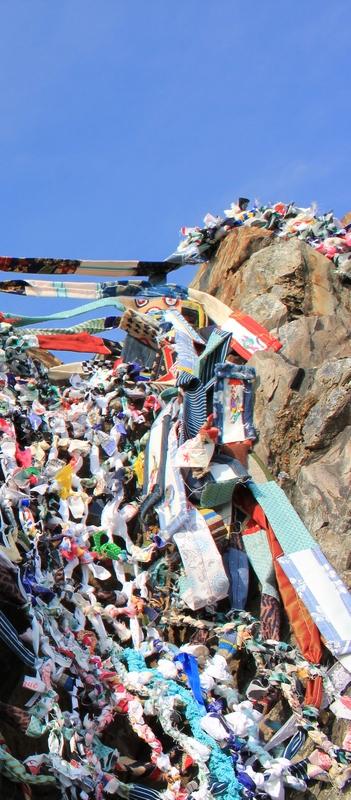
that new media will soon fill the apparent dichotomy between art and technology, to assimilate one to each other: what's your opinion about the relationship between Art production and Technology?
With advancements in photography, software, and video production anyone can produce beautiful images without too much skill.
This can be a double-edge sword. On the one hand, it creates more opportunities for a wider range of people. On the other hand, expensive equipment can only be afforded by a few. The risk is that art becomes increasingly elitist.
The way I see it, there is a love-hate relationship between art production and modern technology. If we’re honest, technology has not always produced amazing things in our society. You can look to the inventions of the atomic bomb, pesticides, and plastic pollution just to name a few. So you can imagine how technology could have a negative effect on art and artists. By contrast, where would we be without the invention of cinematography, which I believe, has greatly benefited humanity when done tastefully.
We are now in an age where we have millions of images at our disposal instantly. Does this create a culture of decreased sensibilities? At what point do you no longer feel anything when you look at an image because you have been bombarded by so many? There is something to be said about simplicity.
Addressing the viewers to reconsider visual hierarchies in the contemporary age, The Plastic Bag Project also inquiries into how visual processes impact the way we understand the world around us. Multidisciplinary artist Angela



Bulloch onced remarked "that works of arts often continue to evolve after they have been realised, simply by the fact that they are conceived with an element of change, or an inherent potential for some kind of shift to occur". Technology can be used to create innovative works, but innovation means not only to create works that haven't been before, but especially to recontextualize what already exists: do you think that the role of the artist has changed these days with the new global communications and the new sensibility created by new media?
Absolutely. As an artist, you now have the possibility of rethinking how your art can be observed by a larger audience on a global scale just by using the Internet. Recently, The Plastic Bag Project was chosen to be exhibited at the International Green Festival in Iran. That would not have been possible without the Internet. In this respect, my art was able to raise awareness across the globe and have a much bigger impact to provoke social change. I’ve also been able to collaborate with other artists working abroad on the same political issues. So in my opinion, the artist has a greater responsibility than ever with the possibility of far-reaching global communications to bring about positive change.
One of the hallmarks of your practice is the capability to create direct involvement with the viewers, who are urged to evolve from a condition of mere spectatorship. So before leaving this conversation we would like to pose a question about the nature of the relationship of your art with your audience. Do you consider the issue of audience reception as being a crucial component of your decision-making process, in terms of
what type of language is used in a particular context?
One of the distinctive features of my artwork is to allow the viewer to interact with the art piece without any interference. With The Plastic Bag Project I encourage people to use their bodies -- pushing, pulling, sitting on it, jumping roping on sections, unraveling and raveling, walking through it, lifting, wearing it, etc. It’s about exploring how the project relates to the individual in the world.
With most installations, I allow others to determine how to present my work in a particular space. In that way, the piece takes on a new life given to it by the installer, who has become a co-creator. As an artist, this connects me to the community and I draw great inspiration from observing others interpretations.
Thanks a lot for your time and for sharing your thoughts, Danielle. Finally, would you like to tell us readers something about your future projects? How do you see your work evolving?
Currently, I am working on a large-scale children’s project that focuses on zero waste and climate change. Art with purpose is important to me. I feel it is my way of helping to bring light to issues that directly impact our environment. I would like to continue working on socio-political projects to help promote a better world.
An interview by Dario Rutigliano, curator and Melissa C. Hilborn, curator peripheral.arteries@europe.com
In his latest oils, Kenneth Susynski’s inspiration is derived from personal, cultural experiences built into narrative, theatrical compositions that have inherent ties to known tales of love and love lost yet are presented in new, adaptive interpretations depicted by actors in his style of figurative expression. He has had numerous solo and group shows both nationally and internationally including the 2015 Palermo International Biennale, Art Caroussel-Louvre, Seattle Art Museum Gallery, and the Sundance Group.
Hello Kenneth and welcome to Peripheral ARTeries: we would start this interview with a couple of questions about your multifaceted background. Over the years, and especially during your early age, you had the chance to bear witness to historical events and customs in diverse cultures and cpuntries, including Germany, Turkey, South Korea, and the United Kingdom: how do thes experience influence the way you currently conceive your works? And in particular, how does your cultural substratum and your travels inform the way you relate yourself to art making and to the aesthetic problem in general?
I was fortunate to have been raised abroad and exposed to a myriad of
culture and traditions, and whereas that has made a tremendous impact upon my personal evolution as a man and a human being, it has had limited influence on my art. Sure - one can see a few elements of Germanic or Italian architecture that subconsciously is reared from my upbringing in some of my older work. Perhaps there are other artistic elements that others see in my work that I do not, yet the truth is that the only pure, direct reference in my art to my upbringing is the fact that I chose to become an artist in the first place, rather than spend a career in an unsatisfying, dismal business suit. All of the wonderful things I have seen in the world somehow added a depth within me, and I should at least offer some beauty back to it.
Your works convey a coherent sense of unity, that rejects any conventional

Suggestions of Glamorous Gotham, 2016
x
oil and india ink on arches paper

classification. Before starting to elaborate about your production, we would suggest to our readers to visit http://www.susynski.com in order to get a synoptic view of your work: in the meanwhile, would you like to tell to our readers something about your process and set up? In particular, do you think that there is a central idea that connects all of your work as an artist?
I am an oil painter – the process is simple enough: I stretch the canvasses myself and try to work on 1-3 pieces at a time to maximize managing the drying times between layers. I did not go to art school and so the formal teachings I’ve had all took place in the museums of Europe and the USA, thus I’m probably violating several thousand sacred tenets of painting – and proud of it too. Most of my abstraction works from past years was done by palette knife and rollers, yet I moved completely to brush a few years ago.
Because I’ve employed divergent styles in my work, I do not think there is any central theme that binds them all together other than the fact that they are all narrative in nature. Landscapes and portrait painting do not interest me, yet I absolutely employ both within my compositions almost universally.
For this special edition of Peripheral
ARTeries we have selected She Wanted To Be Burnt and Hang There Like Fruit, My Soul, Til The Tree Dies, a couple of interesting works that our readers have already started to admire in the introductory pages of this article. What has at once captured our attention of your artistic research is the way you provided the visual results of your analysis with autonomous aesthetics: when walking our readers through the genesis of She Wanted To Be Burnt and Hang There Like Fruit, My Soul, Til The Tree Dies would you tell us your sources of inspiration? And how did you select your subjects?
Both of those specific paintings were part of a short series of works I did in which each piece referenced a specific piece of literary art – none of the paintings were intended to be illustrative depictions of the literature yet rather a basis for my own interpretation as linked to a personal experience of mine.
She Wanted To Be Burnt, for example, is based on Delta of Venus by Anais Nin, who has always been an influence to my art. Selection was easy: my wife and I have a sizeable collection of classic literature and so I didn’t have to go very far for subject matter.
You are a versatile artist and you work
in oil using swathes of juicy color with the assistance of a mixed assembly of palette knives and brushes: when do you recognize that one of the mediums has exhausted it expressive potential to self?
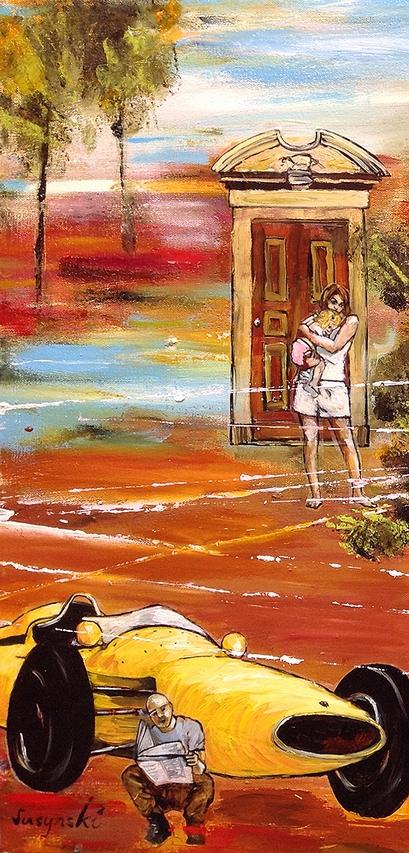
This description is a bit outdated – as I mentioned before, I work solely with the brush these days. I can’t ever imagine oils ever exhausting their potential, yet certain “mixed media” elements that I have used in the past in tandem with oils eventually wore out their appeal quickly when the art started to become gimmicky, and I’ve learned most good collectors see through the gimmicks –they want to see how well you paint, how well you understand color. The only painting of mine ever to be rejected by a gallery which represented me also featured a mixed media of oreo cookies and condoms. And they were right, it was a crap painting.
We can recognize a subtle sociopolitical criticism in how Hang There Like Fruit, My Soul, Til The Tree Dies reminds Abel Meeropol's song performed most famously by Billie Holiday. Mexican artist Gabriel Orozco once stated, "the artist’s role differs depending on which part of the world you’re in. It depends on the political system you’re living under". Not to mention that almost everything, ranging from Caravaggio's


Inspiration of Saint Matthew to Joep van Lieshout's works, could be considered political, what could be in your opinion the role of Art in the contemporary age?
Specific to your question regarding Fruit and in general about my work, I can honestly tell you that I have never created any work with an iota of political reference. Other than Guernica and perhaps Banksy, I have zero interest in art as a political statement nor in making my own political commentary. It’s just not what I want to paint, where’s the beauty in any of that? I do respect all viewer reactions to my work yet they must know my brush is apolitical. Hang There Like Fruit, My Soul, Til The Tree Dies – the title is a line from Shakespeare’s Cymbeline, an impressive production that my beautiful wife and I saw in New Orleans. While on that same culture-rich visit, one day we spontaneously found ourselves becoming part of an authentic second line parade in Treme. The piece is simply a combination of both of those experiences – the revelers in it are each based on characters from the play. And that is the essence of my work –personal experience. Whether in my prior work in abstraction or my current evolution as a figurative expressionist painter, I have tried to paint all of the

experiences the have enlightened me, for better or worse.
As you have remarked once, your inspiration is derived from personal
and cultural experience: however, rather than attempting to establish any univocal sense, you seem to urge the viewers to elaborate personal

Fuku Americanus | 2016 | 48 x 54”| oil on canvas
associations: when discussing about the role of randomness in your process, would you tell us how much important is for you that the spectatorship rethink the concepts
you convey in your pieces, elaborating personal meanings?
When I painted these emotions and experiences in abstract works, there

|
was great randomness in both the process and the spectatorship responses. In my current work that focuses more on representational form, the association to my work is
different – it’s more direct, the narrative is right there, ready to be plucked from the air in front of you, and thus the art is more informative to where I, as the artist, want you to go.


